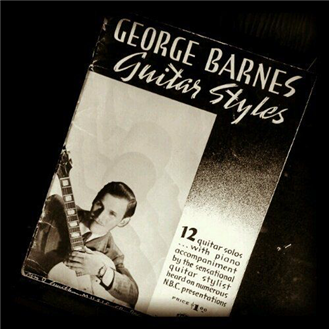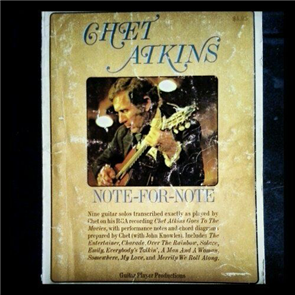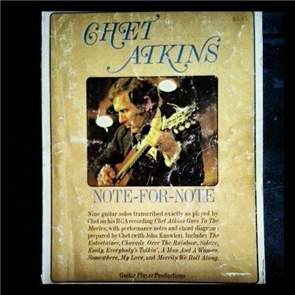Guitar by Randy Buckner
George Barnes “Guitar Style” ~ 1942
Wednesday, September 11, 2019 by Randy Buckner | Method Books
The Book
George Barnes Guitar Styles. Published by William J. Smith: NYC. 39 pages. Copyright 1942. Original cost: $1.00.
Price on eBay or Amazon: good luck finding a copy.
"12 guitar solos - with piano accompaniment - by the sensational guitar stylist heard on numerous NBC presentations."
The Cover
As you can see from the photo, the cover graphics are in the classic late-1930s style I love so well.
The back cover advertises about ten method books, of which Roy Smeck is the only musician I've heard about.
Inside the back cover is an ad for the "George Barnes Guitar Styles" book, Barnes' method book, and a Barnes book titled "Swing Airs."
The last book is an ensemble book with a solo guitar, tenor sax, Bb clarinet, and rhythm section instrumentation. The songs come from the "Guitar Styles" book. I'd like to find that one!!
At the bottom of the page, is a picture of the George Barnes signature pick. It's an extra-heavy tortoise shell pick, which could bought for 1 @ 10¢ or 3 @ 25¢.
Note: because the "George Barnes Guitar Method" was copyrighted in 1943, I think my copy of "Guitar Styles" is a later printing.
From the Forward
The publisher wrote: "Recognized as one of the best amplified guitar artists on the networks... If [George Barnes] keeps going at his present rate, he'll develop into the greatest amplified guitar wizard of all time."
The forward closes with "Barnes is currently working on a method book, and a concerto for guitar; both to be published within a year."
Bio
George Barnes was born 1921 in Chicago, and died 1977 in San Francisco. He started playing the piano at five, but when it was sold to pay for groceries, he switched to guitar. Barnes became a professional musician at twelve, and five years later joined the NBC staff orchestra in Chicago.
In the 1930s, Barnes recorded with such blues artists as Lonnie Johnson, and Big Bill Broonzy. He also worked and recorded with Jimmy Noone, a major musical influence on Barnes.
After working in intelligence during WWII, Barnes resumed his career in Chicago. In the early 1950s, he moved to New York and became one of the most recorded session guitarists of the '50s and '60s. Barnes also signed with Decca, and recorded many solo albums; displaying his genius at arranging, composing, and performing great ensemble music.
In the 1960s and '70s, Barnes performed in duet settings with first, Carl Kress, then Bucky Pizzarelli. He also performed and recorded with Ruby Braff, and Joe Venuti.
In 1977, George Barnes died suddenly, at fifty-six, of a massive heart attack, after changing the strings on his guitar.
What's Inside
I've owned this book for more than thirty years, and it's one of the jewels of my collection. How Barnes was able to write such an advanced book on solo jazz guitar in 1942, is beyond me. At the age of twenty-one, no less.
The style of the songs are exactly like Barnes' guitar work with his late 1940s octet, as well as his mature style later in life.
Granted, the one technique missing in these songs is his skillful, and tasteful, use of bends. However, everything else is here: his inventive use of slides, trills, string skipping, and slurs.
For example, in measures five and six of "Shortin' Bread," Barnes wrote a slide, on the sixth string, which starts on F, ascends to Bb, and then on to G; similar to how a trombonist would play a slide. A very cool sound.
In all of the songs, George skillfully mixed triads with large interval leaps - 7ths and 9ths - and very interesting chord changes. For example: F7-A7-Dm-Dbm6-Bm6-Bbm6-A7-Dm.
I really like Barnes' use of double stops. He wrote them in 3rds, 4ths, 5ths, and 6ths. While playing the arrangements, I heard where Chet Atkins' use of double stops was influenced by Barnes.
All-in-all, these are twelve excellent, and gig-ready, songs worth analyzing and learning.
Final Thoughts
This book is the one to get if
A: you want to learn George Barnes' style.
B: you want to learn a swing guitar style different from Charlie Christian, Les Paul, Oscar Moore, etc.
C: you want to add some awesome guitar licks to your collection.
D: All of the above.
Barnes is becoming more well-known today, thanks to the internet, and especially his daughter, Alexandra Barnes Leh. She has some very interesting projects in the works that you don’t want to miss out on. While you can locate Barnes’ recordings on the internet, your best resource for all things George Barnes is here: The George Barnes Legacy Collection Website
His music is very enjoyable, it swings hard, and you can hear the influence of George's heroes in his playing: Jimmy Noone, Lonnie Johnson, Louis Armstrong, and Bix Beiderbecke.
If you're a student, or performer, of swing guitar jazz, you really should become better acquainted with George Barnes.
Until next time ~
Randy Buckner: Hoover Music Co., Springfield, Mo.
www.bucknerguitar.us
Part Two: “Chet Atkins Note-for-Note”
Tuesday, September 10, 2019 by Randy Buckner | Method Books
The Songs
Nine songs from Atkins' album, "Chet Atkins Goes to the Movies," were transcribed for this book:
"Emily" "Charade" "Solace" "The Entertainer" "A Man and a Woman" "Somewhere Over the Rainbow" "Everybody's Talkin" "Somewhere My Love" and "Merrily We Roll Along."
No Tab
When Knowles initially discussed the project with the editors at Guitar Player, the subject of tablature came up. The editors were west coast jazz guys, and they thought nobody would use tab. They didn't realize Stefan Grossman had been using it for years in his books.
As soon as Knowles realized tab wasn't going to be used - and knowing notation alone would not reveal chord shapes and positions - he decided to use chord diagrams and performance notes to explain the songs.
Knowles explained, "The analytical part of me [devised] the whole thing of numbering each line of music" to correspond with the chord diagrams. This made it easier to match a chord diagram with a specific point in the music.
Performance Notes
Knowles noticed - while teaching students a new piece of music - "over half of [the song] contained things they already knew how to do." So the idea behind the performance notes was Knowles, as the teacher, pointing out difficult passages of the music to the student via the page.
Charade
Asked which songs were the most difficult to transcribe, Knowles replied "Over the Rainbow" because of the harmonics, and "Charade" because of the flanger Atkins used on the recording.
Knowles often fields questions about "Charade." Why? Because the transcription doesn't match the recording. Well, the notes are right, the music is just out of sequence.
As Knowles explained, "I had printed some staff paper that had seven lines," and after Guitar Player received the manuscript , they cut it "to where it had the right number of lines per page." During the process of pasting the manuscript, the first two pages of "Charade" were switched.
Looking at the transcription, the first seven lines are page two, the next seven are page one, and the remaining lines are page three. So, "Charade" actually starts on the third line down on page 24, where it says 4/4.
Final Thoughts
In the world of fingerstyle guitar, "Chet Atkins Note-for-Note" is a landmark book. No book before it explained Chet's style so simply - and so detailed - that even a middle-school guitar fanatic in Springfield, Mo. could easily learn his style of playing. The songs themselves are individual lessons on how to play like Atkins.
The look of the music notation is very artistic. When Knowles said it was written in calligraphy with a fountain pen - and the aid of bottles of "White Out" - I was impressed even more.
Unfortunately, there are no plans to publish the book again. Knowles doesn't know who owns the rights.
However, Knowles has re-arranged some of the songs, and published them in his quarterly magazine. Maybe someday, whoever owns the rights will understand the goldmine they have, and publish the book for a new generation of thumbpickers to study.
Recently, as I played through the songs again - it felt as if I was meeting up with a group of old friends.
Until next time ~
Randy Buckner.
Hoover Music Co.
Springfield, Mo.
www.bucknerguitar.us
Part One: “Chet Atkins Note-for-Note”
Monday, September 9, 2019 by Randy Buckner | Method Books
When I was in middle school, I ran across an ad in Guitar Player Magazine. The advertisement was for a book of songs recorded by one of my heroes, Chet Atkins. I immediately ordered it, because the songs were transcribed from my favorite album, "Chet Atkins Goes to the Movies." Here are my thoughts on one of the most important books in my collection.
The Book
Chet Atkins Note-for-Note
By Chet Atkins and John Knowles. Copyright June 1975, by Guitar Player Productions. 72 pages. Cost of my copy: $4.95.
Cost Today
I have found examples of this book on eBay and Amazon ranging in price from $45 - $100.
What's Inside
The majority of the text was written by Knowles, with exception of the preface, which was written by Atkins. It was handwritten by Knowles, then typewritten by his wife, Becky.
Introduction
The introduction - like all the text - was originally written in first person. Knowles wrote it as if he were teaching a student how to play Atkins' music. The publishers - thinking no one knew who Knowles was - changed the text to Atkins' voice.
In the introduction, Knowles' advice to follow the score while listening to the record helped me understand the relationship between music notation and the actual performance.
Knowles suggested that when listening to the recording, listen to the melody and bass individually; identify the intro, verse, and bridge; and to listen for Atkins' articulations.
Thumb Technique
This chapter explained Atkins' thumb-work in such a way, even a self-taught middle-schooler - like me - could figure it out.
First, Knowles explained why a thumbpick was essential for the Atkins style.
He then explained the concept of a steady bass rhythm, followed by examples of Atkins' alternating bass patterns written for seven different chords. As far as I was concerned, this was the Rosetta Stone of all things Atkins.
The chapter closed with an introduction to playing the melody on top of an alternating bass. Knowles demonstrated how different melodic rhythms - quarter, half, and eighth - fit together with the bass line. Very enlightening to a beginning thumbpicker.
Anticipating the Melody
This chapter, although shorter than the rest, really summed up the Atkins style.
Knowles showed us how, while playing a song, Atkins would anticipate the melody.
In other words, picking the melody slightly ahead of the beat, thus giving Atkins' music the lilt and swing which had evaded most mortal guitarists. Again, something I had not seen in a book before buying this one.
Harmonics
This chapter tied a neat little bow around Atkins' style for me. Knowles explained not only how to play artificial harmonics, but how to combine them with a pure tone.
Because I had bought this book so early in my journey as a student, I didn't understand why others found it hard to play harmonics. Knowles explained them in such a way, it was easy to play harmonics like Atkins.
However, for Knowles, it wasn't so easy. He originally thought Atkins was playing a scale entirely of harmonics.
Knowles called Atkins, and Chet explained the technique over the phone. After a long silence, the conversation went like this: "You haven't got it yet, do you?"..."No"..."You will. Call me back when you've got it."
Knowles went to work, and figured out the technique. As we now know, Atkins would alternate a harmonic with a pure tone, creating what Knowles calls a cascade of notes.
Knowles then devised a way to write a "cue note" on the staff, to show where a harmonic occurs in the music.
My next post will be about the songs in the book.
Randy Buckner.
Hoover Music Co.
Springfield, Mo.
www.bucknerguitar.us




